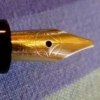Search the Community
Showing results for tags 'vacuum'.
-
So I have wanted a vacuum filler for quite some time. I bought some Chinese one from AliExpress last year to try them out- the filling mechanism is fabulous but they don't post, which is a deal-breaker for me in any pen that isn't retractable. PenBBS says their Vac fillers don't post. The TWSBI pe...
- 16 replies
-
- vac filler
- vacuum
-
(and 2 more)
Tagged with:
-
nibs Seeking /a/ vac fillers which have 1.5mm nibs and/or /b/ 1.5mm nibs which fit TWSBI vac fillers
KateGladstone posted a topic in Of Nibs & Tines
I’m seeking vac fillers which have 1.5mm stub or italic nibs (do they exist?) and/or 1.5mm stub or italic nibs which fit TWSBI GO and/or SWIPE vac fillers. Do these exist? (They need not be from TWSBI — I enjoy Frankenpenning.) Also, what chance is there of anyone being able to persuades... -
Hello again to all my FPN friends, Today the long awaited Penbbs 456 vac-filler arrived in the mail, so I thought I'd give everyone still waiting for theirs on the slow boat from China to see what they have to look forward to. Below are just a few impressions after filling it up and taking it for...
-
Hi all, I took a punt on a vacuum fill Sheaffer Feather-Touch with a military clip cap (the type where the clip bends over the cap's top), and it's sold as unrestored. I'm in the UK, and wondered if anyone had a recommendation for a UK-based repair person?
-
First Attempt On Pen Turning, A Stipula Etruria Lookalike
Hardy08 posted a topic in Pen Turning and Making
I was frustrated on a pen I bought: a Stipula Etruria Gallicana in Oronero color with a stiflexnib. This pen was gorgeous at first sight, but some drawbacks refrained me from using it daily: -It could only hold a small amount of ink: it is a CC filler. -The feed was a disaster as it was not suita... -
The Custom 823 pens have always been highly captivating demonstrators from Pilot Corporation (Japan), sporting the second largest nib (Pilot#15, Namiki#20 nibsize), with a vacuum plunger filling mechanism. The model number 823 refers to the price and year, of launch, although in a slightly intricate...
- 111 replies
-
- pilotcustom
- 823
-
(and 5 more)
Tagged with:
-
As the title says. I realised that my nib was running a little dry and, as with a lot of vacuum fillers, I went to unscrew the piston knob at the top to break the seal so more ink could flow through. However, upon trying I literally could not move this piston knob no matter how hard I try. Grante...
- 4 replies
-
- twsbi
- troubleshoot
-
(and 3 more)
Tagged with:
-
I bought a little silver ringtop on eBay: a Tiffany pen with a William Hicks nib. It's not especially different from other pens of this type, just subtly xbetter, more carefully made. Except for one thing: it leaked. When I uncapped the pen, the section would be covered with ink. I wore it to the L....
-

Review Of A Twsbi Vac 700 With A Vac 20 Travel Inkwell
sannidh posted a topic in Fountain Pen Reviews
Over time, I observed that the 580 could not find much use, primarily because my writing preferences have graduated towards softer and larger nibs along with time. So here comes the saviour from TWSBI - The Vac 700, with a bigger nib of #6 size, and a vacuum plunger mechanism. Personally, I prefer t... -
Hi there. I have a vintage Pilot vacuum filler pen and I was wondering if anyone could identify it. It has a vacuum filling reservoir but there isn't a seal on the o-ring so it won't fill. I am trying to take it apart in order to see what needs to be fixed but don't want to break it. I think it...
-

Advice On Buying A Sheaffer Lever Fill Or Vac Fill? Which One? How Much?
boybacon posted a topic in Sheaffer
Hello, Everyone! Some 35 years ago, my great grandfather gave me a fountain pen out of his "junk drawer". I took it home, found some ink somewhere and actually wrote/drew with it. Then, at some point (because my dad told me I should) attempted to clean it with nail polish remover. It softened t...









